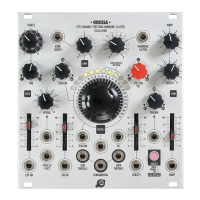21kHz. Therefore, the usable range of the big
knob depends on pitch frequency. For high-
pitched sounds, the frequency of most of the
overtones would be too high, hence increasing
this parameter above a certain number will
not create any audible effect.
There is a fundamental problem with additive
synthesis as it relates to dynamic range: a sum
of many sinusoids may be much louder than
just a single sinusoid (or a few). For example,
50dB. For practical reasons, Odessa applies a
perceptually optimized volume compensation
to the output signal. You may notice that the
low-frequency partials become quieter when
the energy of higher partials increases. The
result is similar to what you hear when com-
paring the loudness of different waves from a
traditional VCO.
The tilt parameter determines how quickly
the spectrum decays (how quickly the ampli-
tudes of partials decrease with frequency). This
-
in the partial amplitude formula: A
n
=A
1
/n
.
7
The spectrum of a saw wave contains all overtones in a naturally decaying harmonic series: the am-
plitude of each harmonic partial is inversely proportional to its number: A
n
=A
1
/n (A
1
is the amplitude
-
ic partials missing because their spectra are shaped by a Sinc function which introduces a series of
notches: A
n
=A
1
spectrum
parameters
0 0.5 1 1.5 2
1
0.5
0
-0.5
Time
AmplitudeAmplitude
0 0.5 1 1.5 2
1
0.5
0
-0.5
-1
Time
5 10 15 20 25 30
1
0.8
0.6
0.4
0.2
Partial number
0
0 5 10 15 20 25 30
1
0.8
0.6
0.4
0.2
Partial number
AmplitudeAmplitude
AmplitudeAmplitude
sawtooth and pulse waveforms and their respective harmonic spectra (truncated for clarity).
AmplitudeAmplitude

